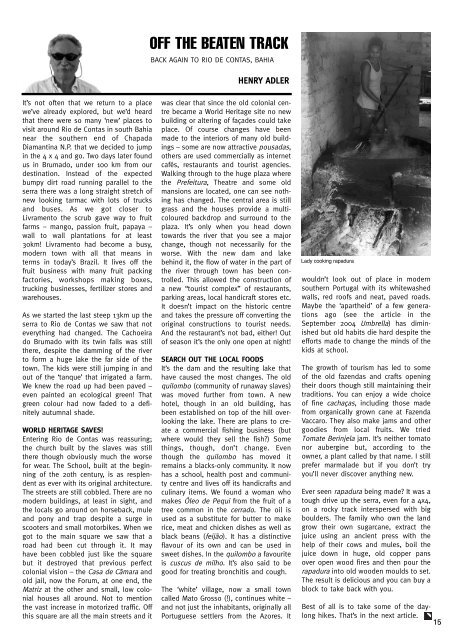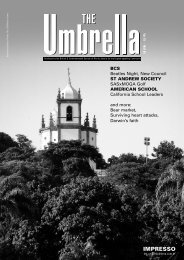Create successful ePaper yourself
Turn your PDF publications into a flip-book with our unique Google optimized e-Paper software.
OFF THE BEATEN TRACK<br />
BACK AGAIN TO RIO DE CONTAS, BAHIA<br />
HENRY ADLER<br />
It’s not often that we return to a place<br />
we’ve already explored, but we’d heard<br />
that there were so many ‘new’ places to<br />
visit around <strong>Rio</strong> de Contas in south Bahia<br />
near the southern end of Chapada<br />
Diamantina N.P. that we decided to jump<br />
in the 4 x 4 and go. Two days later found<br />
us in Brumado, under 100 km from our<br />
destination. Instead of the expected<br />
bumpy dirt road running parallel to the<br />
serra there was a long straight stretch of<br />
new looking tarmac with lots of trucks<br />
and buses. As we got closer to<br />
Livramento the scrub gave way to fruit<br />
farms – mango, passion fruit, papaya –<br />
wall to wall plantations for at least<br />
30km! Livramento had become a busy,<br />
modern town with all that means in<br />
terms in today’s Brazil. It lives off the<br />
fruit business with many fruit packing<br />
factories, workshops making boxes,<br />
trucking businesses, fertilizer stores and<br />
warehouses.<br />
As we started the last steep 13km up the<br />
serra to <strong>Rio</strong> de Contas we saw that not<br />
everything had changed. The Cachoeira<br />
do Brumado with its twin falls was still<br />
there, despite the damming of the river<br />
to form a huge lake the far side of the<br />
town. The kids were still jumping in and<br />
out of the ‘tanque’ that irrigated a farm.<br />
We knew the road up had been paved –<br />
even painted an ecological green! That<br />
green colour had now faded to a definitely<br />
autumnal shade.<br />
WORLD HERITAGE SAVES!<br />
Entering <strong>Rio</strong> de Contas was reassuring;<br />
the church built by the slaves was still<br />
there though obviously much the worse<br />
for wear. The School, built at the beginning<br />
of the 20th century, is as resplendent<br />
as ever with its original architecture.<br />
The streets are still cobbled. There are no<br />
modern buildings, at least in sight, and<br />
the locals go around on horseback, mule<br />
and pony and trap despite a surge in<br />
scooters and small motorbikes. When we<br />
got to the main square we saw that a<br />
road had been cut through it. It may<br />
have been cobbled just like the square<br />
but it destroyed that previous perfect<br />
colonial vision – the Casa de Câmara and<br />
old jail, now the Forum, at one end, the<br />
Matriz at the other and small, low colonial<br />
houses all around. Not to mention<br />
the vast increase in motorized traffic. Off<br />
this square are all the main streets and it<br />
was clear that since the old colonial centre<br />
became a World Heritage site no new<br />
building or altering of façades could take<br />
place. Of course changes have been<br />
made to the interiors of many old buildings<br />
– some are now attractive pousadas,<br />
others are used commercially as internet<br />
cafés, restaurants and tourist agencies.<br />
Walking through to the huge plaza where<br />
the Prefeitura, Theatre and some old<br />
mansions are located, one can see nothing<br />
has changed. The central area is still<br />
grass and the houses provide a multicoloured<br />
backdrop and surround to the<br />
plaza. It’s only when you head down<br />
towards the river that you see a major<br />
change, though not necessarily for the<br />
worse. With the new dam and lake<br />
behind it, the flow of water in the part of<br />
the river through town has been controlled.<br />
This allowed the construction of<br />
a new “tourist complex” of restaurants,<br />
parking areas, local handicraft stores etc.<br />
It doesn’t impact on the historic centre<br />
and takes the pressure off converting the<br />
original constructions to tourist needs.<br />
And the restaurant’s not bad, either! Out<br />
of season it’s the only one open at night!<br />
SEARCH OUT THE LOCAL FOODS<br />
It’s the dam and the resulting lake that<br />
have caused the most changes. The old<br />
quilombo (community of runaway slaves)<br />
was moved further from town. A new<br />
hotel, though in an old building, has<br />
been established on top of the hill overlooking<br />
the lake. There are plans to create<br />
a commercial fishing business (but<br />
where would they sell the fish) Some<br />
things, though, don’t change. Even<br />
though the quilombo has moved it<br />
remains a blacks-only community. It now<br />
has a school, health post and community<br />
centre and lives off its handicrafts and<br />
culinary items. We found a woman who<br />
makes Óleo de Pequi from the fruit of a<br />
tree common in the cerrado. The oil is<br />
used as a substitute for butter to make<br />
rice, meat and chicken dishes as well as<br />
black beans (feijão). It has a distinctive<br />
flavour of its own and can be used in<br />
sweet dishes. In the quilombo a favourite<br />
is cuscus de milho. It’s also said to be<br />
good for treating bronchitis and cough.<br />
The ‘white’ village, now a small town<br />
called Mato Grosso (!), continues white –<br />
and not just the inhabitants, originally all<br />
Portuguese settlers from the Azores. It<br />
Lady cooking rapadura<br />
wouldn’t look out of place in modern<br />
southern Portugal with its whitewashed<br />
walls, red roofs and neat, paved roads.<br />
Maybe the ‘apartheid’ of a few generations<br />
ago (see the article in the<br />
September 2004 Umbrella) has diminished<br />
but old habits die hard despite the<br />
efforts made to change the minds of the<br />
kids at school.<br />
The growth of tourism has led to some<br />
of the old fazendas and crafts opening<br />
their doors though still maintaining their<br />
traditions. You can enjoy a wide choice<br />
of fine cachaças, including those made<br />
from organically grown cane at Fazenda<br />
Vaccaro. They also make jams and other<br />
goodies from local fruits. We tried<br />
Tomate Berinjela jam. It’s neither tomato<br />
nor aubergine but, according to the<br />
owner, a plant called by that name. I still<br />
prefer marmalade but if you don’t try<br />
you’ll never discover anything new.<br />
Ever seen rapadura being made It was a<br />
tough drive up the serra, even for a 4x4,<br />
on a rocky track interspersed with big<br />
boulders. The family who own the land<br />
grow their own sugarcane, extract the<br />
juice using an ancient press with the<br />
help of their cows and mules, boil the<br />
juice down in huge, old copper pans<br />
over open wood fires and then pour the<br />
rapadura into old wooden moulds to set.<br />
The result is delicious and you can buy a<br />
block to take back with you.<br />
Best of all is to take some of the daylong<br />
hikes. That’s in the next article.<br />
15






